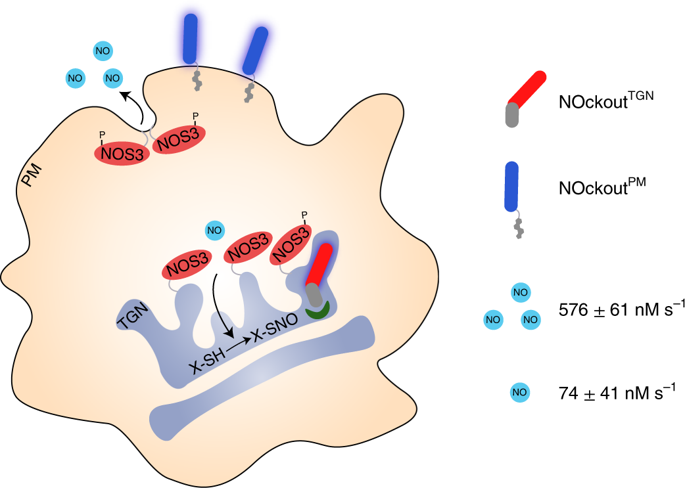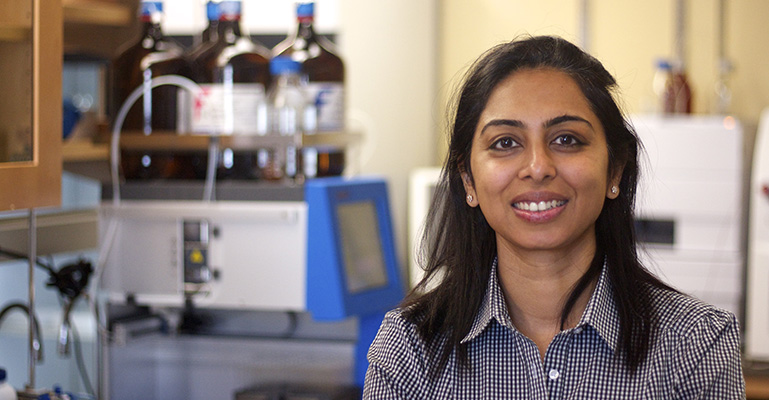March 11, 2020 I Jola Glotzer
On the heels of NOS
Yamuna Krishnan, UChicago, publishes in Nature Chemical Biology the results of her CBC Catalyst Award-supported research on the development of a novel tool enabling live tracking of nitric oxide synthase (NOS) subcellular localization and activity
Posttranslational modifications of proteins are necessary for proper functioning of many cell signaling processes. One type of posttranslational modification – S-nitrosylation – requires access to the highly reactive nitric oxide (NO) groups which are synthesized within cells by an enzyme called nitric oxide synthase (NOS). NOS activity and NO levels have been implicated as culprits in the pathogenesis of many diseases including cancer as they affect cell proliferation, apoptosis, angiogenesis, metastasis and the immune response. Interestingly, both too low or two high levels of NO can cause deleterious effects in a cell. Low NO level is tumorigenic whereas high NO levels actually play a protective, antitumorigenic role. Hence, NOS activity must be tightly controlled to keep NO levels adequately balanced in the cells for them to stay healthy.
Different isoforms of NOS exist, and they localize either at the plasma membrane or at the trans-Golgi network (TGN). However, the physiological role of these two subcellular NOS activity-containing compartments as well as their contribution to the pathological processes are largely unknown.
The Krishnan lab at UChicago has developed a tool that can simultaneously visualize and distinguish between the two NOS populations in living cells. As described in a recent article published in Nature Chemical Biology, the system employs a fluorescent DNA-based probe technology, called NOckout, that can specifically target either the plasma membrane or the TGN and quantitatively map local activities of NOS. The technology is a stepping stone to begin addressing specific questions about spatio-temporal activity of NOS in health and diseases.
Yamuna Krishnan is Professor of Chemistry at UChicago. She is also a winner of a 2017 CBC Catalyst Award for the project “In situ Lysosomal Ion Imaging as a Sensitive Diagnostic for Lysosomal Disorders.” The Catalyst Award is acknowledged for partially funding the current study.
Congratulations to Krishnan and all co-authors on the Nature Chemical Biology publication!
Publication attributed to *CBC funding:
Jani MS, Zou J, Veetil AT, Krishnan Y. A DNA-based fluorescent probe maps NOS3 activity with subcellular spatial resolution. Nat Chem Biol. 2020 Mar 9. [Epub ahead of print] (PubMed)
ABSTRACT:

Graphical abstract. (Source: Nat Chem Biol. 2020 Mar 9.)
Nitric oxide synthase 3 (NOS3) produces the gasotransmitter nitric oxide (NO), which drives critical cellular signaling pathways by S-nitrosylating target proteins. Endogenous NOS3 resides at two distinct subcellular locations: the plasma membrane and the trans-Golgi network (TGN). However, NO generation arising from the activities of both these pools of NOS3 and its relative contribution to physiology or disease is not yet resolvable. We describe a fluorescent DNA-based probe technology, NOckout, that can be targeted either to the plasma membrane or the TGN, where it can quantitatively map the activities of endogenous NOS3 at these locations in live cells. We found that, although NOS3 at the Golgi is tenfold less active than at the plasma membrane, its activity is essential for the structural integrity of the Golgi. The newfound ability to spatially map NOS3 activity provides a platform to discover selective regulators of the distinct pools of NOS3.
ACKNOWLEDGMENTS:
We thank J. Kuriyan and W.C. Sessa for valuable discussions. We thank Y. Fang for technical discussions and for the reagents used in biochemical studies of NOS3. We thank the Integrated Light Microscopy facility and BioPhysics core facility at the University of Chicago. We thank M. Zajac for a critical reading of the manuscript. This work was supported by a research grant from the University of Pennsylvania Orphan Disease Center in partnership with the Andrew Coppola Foundation, the University of Chicago Women’s Board; a Pilot and Feasibility award from an NIDDK center grant no. P30DK42086 to the University of Chicago Digestive Diseases Research Core Center; the Chicago Biomedical Consortium, with support from the Searle Funds at The Chicago Community Trust, C-084; a Scientific Innovation Award from the Brain Research Foundation and the Mergel Funsky award to Y.K.
Featured CBC Community member:
Yamuna Krishnan, UChicago
- *CBC Catalyst Award (2018):
▸ In situ Lysosomal Ion Imaging as a Sensitive Diagnostic for Lysosomal Disorders
PIs: Yamuna Krishnan (UChicago) and Dimitri Krainc (NU) - CBC Postdoctoral Research Award (2015):
▸ Quantitative and Spatiotemporal Detection of Endogenously Produced H2S in Cardiovascular System
PIs: Krishna Dan (postdoc) and Yamuna Krishnan (UChicago)
ARTICLES PUBLISHED IN THE PAST ABOUT THE FEATURED CBC COMMUNITY MEMBER:
DECEMBER 18, 2019
▸ Cite us — we’ll “cite” you back!
Twenty-three recent publications attributed to eighteen CBC Awards contribute to a total of 2463 publications that are the result of CBC-sponsored research to date
JANUARY 25, 2019
▸ Lysosomes under surveillance
TWO high-impact publications from the Krishnan lab at UChicago, in Nature Nanotechnology and in Nature Methods, attributed to a recent CBC Catalyst Award!

